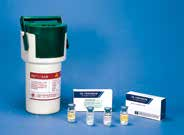Nuclear Medicine
Medical use of isotopes in China began in the 1950s. The development of radiopharmaceuticals kicked off in the early 1960s. Medical isotopes were included in medication management in 1974 and radiopharmaceuticals were listed in the Pharmacopoeia of the People's Republic of China in 1977 for the first time. The Measures for Management of Radiopharmaceuticals, promulgated by the State Council in 1989, specifies strict guidelines regarding the development, production, clinical trials, and approval of the use of radiopharmaceuticals. The production of radiopharmaceuticals must meet national radiopharmaceutical production standards. Nuclear medicine imaging has become a widely used tool in clinical diagnosis and treatment. Medical molybdenum-99/ technetium-99m generators are produced domestically on a large scale in line with international standards. Technetium-99m-based radiopharmaceuticals are widely used in diagnostic imaging. Iodine-125 sources are used for cancer treatment. Domestic production of 18F-FDG PET for diagnosis has taken shape. Urea breath test kits labeled with carbon-13 or carbon-14 are widely used for detecting Helicobacter pylori infection. Medical isotope strontium-89 is also produced domestically. Its use greatly benefits patients with bone metastases. The China Isotope & Radiation Corporation is a main supplier of radiopharmaceuticals in China.

核醫藥
中國醫用同位素應用始于20世紀 50年代。60年代初,中國開始研制放射性藥物,1974年將醫用同位素納入藥品管理。《中國藥典》1977年版首次收載放射性藥品,1989年國務院頒布了《放射性藥品管理辦法》,對放射性藥物的研制、生產、臨床研究和審批等事項作出了嚴格的規定。中國放射性藥物生產符合國家制造標準。核醫學顯像診斷和治療建立了完整的臨床應用體系。醫用鉬-99/锝-99m發生器已實現國產化、規模化生產,產品質量與國際接軌。锝-99m顯像藥物已普遍應用,可滿足臨床診斷需要。碘-125粒子源已在臨床用于多種腫瘤的治療。PET診斷用正電子藥物18F-FDG已實現國產化。碳-13、碳-14呼氣檢測試劑盒在檢測幽門螺桿菌感染的推廣應用中發展迅速。醫用同位素鍶-89也已成功實現國產化,為癌癥骨轉移患者帶來福音。中國同輻公司為放射性藥物的主要供應商。
